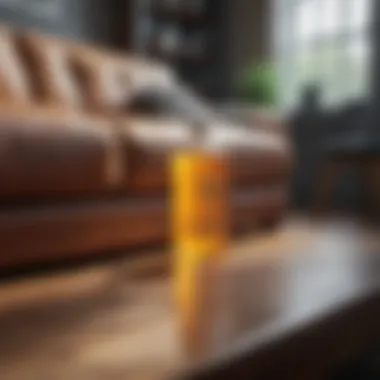Deep Cleaning Your Couch: A Comprehensive Guide


Intro
Deep cleaning a couch is often an overlooked task in routine household chores. Many homeowners tend to underestimate the significance of a thorough cleaning session. It is not just about aesthetic appeal; it plays a vital role in maintaining the health and longevity of the furniture. As couches typically see extensive use, they attract dust, allergens, and stains over time. The importance of clean furniture cannot be diminished. An unkempt couch can negatively affect both the visual appeal of a living space and the well-being of its occupants.
In this guide, we will explore various dimensions of deep cleaning your couch. From understanding different couch materials to utilizing appropriate cleaning solutions, we will cover everything you need to know. Our focus includes the right tools, techniques, and care practices necessary for effective cleaning. Each step is catered to enhance your understanding and ensure a thorough deep cleaning experience.
This resource serves not only homeowners but also interior design enthusiasts who value the aesthetic and functional integrity of their living spaces. Hence, let’s delve deeper into the first section which highlights the key characteristics of furniture and its significance within home features.
Prologue
Deep cleaning your couch is not just a task; it's a necessary practice for those who wish to maintain a clean and inviting living space. Couches can accumulate dust, allergens, and stains over time, creating an unwelcoming environment. This article provides a structured approach to deep cleaning, empowering homeowners, interior design enthusiasts, and anyone who values their living space.
Couches represent a significant investment in home furnishings. Regular deep cleaning helps to enhance the longevity of this investment. The process also promotes hygiene, a critical aspect in our increasingly health-conscious world. Understanding how to deep clean properly is essential—it ensures that your couch remains aesthetically pleasing and functional for years to come.
Consideration should also be given to the various materials used in couch construction. Not all couches are created equal; fabric, leather, and microfiber require different care techniques. This guide will delve into the specific needs of each material, ensuring that readers can adopt a tailored cleaning approach.
In summary, this introduction sets the stage for a comprehensive exploration of couch cleaning techniques, tools, and solutions. Gaining insights from this guide will enable you to uphold both the appearance and hygiene of your couch, thereby enhancing your overall living experience.
The Importance of Deep Cleaning
Deep cleaning your couch is an activity that bears significant importance for both hygiene and maintenance of the furniture. A couch is often the centerpiece of a living room, a gathering spot for family and friends. Thus, its cleanliness directly impacts the overall atmosphere of your living space. The importance of deep cleaning cannot be overstated as it contributes to multiple facets of couch care.
Firstly, regular deep cleaning has the potential to extend the longevity of the couch. Different materials, such as fabric and leather, have specific cleaning needs. By adhering to a thorough cleaning regime, you actively work against wear and tear, ultimately slowing down the aging process of your furniture. A well-cared-for couch can serve its purpose for many years, often becoming a cherished item.
Secondly, promoting hygiene is vital. Couches can harbor allergens, dust mites, and bacteria accumulated over time. These unwanted guests can lead to health issues, including respiratory problems and allergies. Deep cleaning eliminates these health threats, ensuring a safer environment for you and your loved ones. It’s essential to remember that a clean couch contributes to your overall well-being.
Lastly, improving aesthetic appeal is often a primary consideration. A clean couch enhances your entire room's look. Stains, dirt, and unpleasant odors detract from the ambiance of any space. By deep cleaning, you ensure that your couch remains an attractive feature. This not only elevates your interior design but can also impress guests and buyers alike.
Identifying Your Couch Material
Understanding the material of your couch is essential before undertaking deep cleaning. Each fabric has unique properties and responses to cleaning solutions. This knowledge allows you to select appropriate products and techniques, which can significantly affect the cleaning outcome.
In addition, recognizing the couch material aids in preventing damage. Some fabrics react poorly to water, while others may fade or change texture with harsh chemicals. Thus, identifying your couch material can enhance cleaning efficiency, prolong the life of the upholstery, and maintain aesthetic appeal.
Fabric Couches
Fabric couches are popular due to their comfort and wide variety of styles. They generally require regular vacuuming to minimize dust and allergens. For deep cleaning, spot cleaning is essential to address stains.
When using a cleaning solution, always test in a small, inconspicuous area first. Some fabrics may require water-based cleaners, while others can handle solvent-based solutions. Frequent deep cleaning can help retain the soft texture and color of fabric couches.
Leather Couches
Leather couches offer elegance and durability. However, they need special care to maintain their quality. Unlike fabric, leather is sensitive to moisture. Therefore, using too much water can lead to cracking or discoloration.
Cleaning leather involves using a soft cloth with a designated leather cleaner. It is also important to condition the leather periodically to keep it supple. By keeping leather couches clean and conditioned, you can prolong their lifespan significantly.
Microfiber Couches
Microfiber couches are known for their stain resistance and easy maintenance. This synthetic fabric allows you to clean with minimal water, often with just a damp cloth. Stains can usually be removed with a simple mixture of water and mild detergent.


However, avoid the use of harsh chemicals. They can damage the fabric and affect its texture. Regular vacuuming is crucial to prevent dirt buildup and maintain the fabric's integrity. Overall, microfiber couches offer a practical option for busy households, showing long-term durability when properly maintained.
Essential Tools for Deep Cleaning
Deep cleaning your couch effectively requires more than just a good technique. The right tools can make a significant difference in achieving the desired results. Essential tools for deep cleaning not only enhance your cleaning efficiency but also ensure that different couch materials get the specific care they need. Understanding these tools helps avoid common pitfalls that can lead to damage or ineffectiveness. In this section, we will explore three primary tools that are indispensable for maintaining your couch’s cleanliness and integrity: the vacuum cleaner, brushes and cloths, and stain removers.
Vacuum Cleaner
A vacuum cleaner is arguably the most important tool when deep cleaning a couch. Its main function is to remove dust, dirt, and debris, which can accumulate over time. A vacuum equipped with various attachments can adapt to different surfaces and reach crevices that are challenging to clean by hand.
Using a vacuum regularly helps to maintain the couch's appearance. It prevents this build-up from becoming embedded in the fabric, which can lead to odors or stains. Moreover, a high-quality vacuum cleaner combines strong suction with gentle brush rollers, suitable to clean delicate fabrics without causing wear.
When selecting a vacuum cleaner, consider the types of attachments it comes with. A nozzle designed for upholstery is essential, as it allows for targeted cleaning. Additionally, a vacuum with a HEPA filter can trap allergens, making the environment healthier, especially for those with allergies.
Brushes and Cloths
Brushes and cloths serve as complementary tools to the vacuum. They come in handy for scrubbing the couch's surface and removing any stubborn stains or marks that the vacuum cannot dislodge. The type of brush used can depend on the couch material. For instance, a soft-bristled brush works excellently on fabric couches, while a leather-specific brush will help maintain the surface of leather couches without scratching.
Cloths are equally important, helping to wipe surfaces after vacuuming or spot cleaning. Microfiber cloths are recommended because they are absorbent and trap dirt effectively. It is crucial to use a clean cloth each time to prevent spreading dirt and grime rather than removing it.
Stain Removers
Stain removers are specialized solutions designed to tackle specific types of stains on couches. Regular cleaning may not always suffice to remove spills or stubborn marks. Therefore, having a reliable stain remover can make all the difference in maintaining the couch’s appearance.
It is crucial to choose a stain remover that aligns with your couch material. For instance, fabric couches might require an enzyme-based cleaner, while leather requires a pH-balanced cleaner to avoid damage. Ensure to test any stain remover on a hidden area before applying it to visible spots. This precaution prevents unforeseen discoloration or damage.
"Using the correct tools and cleaning solutions ensures that deep cleaning efforts are effective and do not compromise your couch’s integrity."
Preparing for the Cleaning Process
Preparing your couch for a deep clean is a crucial step that can make the entire process smoother and more effective. This phase involves several important actions aimed at ensuring all parts of the couch are accessible and ready for thorough cleaning. Proper preparation can significantly enhance the efficiency of your cleaning task and prevent accidental damage to the furniture.
Removing Cushions
One of the first tasks in the preparation stage is to remove all cushions from the couch. This step is essential for a few reasons. First, it allows for complete access to all surfaces of the couch, including areas often overlooked, such as beneath the cushions
By removing the cushions, you can effectively clear out dust, debris, and hidden stains. Cushions can collect crumbs and residue over time, which can contribute to unpleasant odors if not addressed. It is advisable to vacuum each cushion separately before proceeding with any cleaning solutions.
When handling removable cushions, it's important to check their fabric type. Different materials may have unique cleaning requirements, so knowing what you are dealing with can prevent damage during the cleaning process.
Checking Labels for Cleaning Instructions
After removing the cushions, the next step is to examine the care labels attached to the couch and cushions. This is an often-neglected aspect of couch maintenance.
The label usually provides valuable information regarding the appropriate cleaning methods and solutions to use. Fabrics may have specific cleaning codes, such as "W" for water-based cleaners, "S" for solvent-based cleaners, or a combination of any two. Ignoring the manufacturer's guidelines can lead to undesirable results, such as discoloration or shrinkage.
Check your couch's label before cleaning; it’s key to maintaining its quality and appearance.
In summary, proper preparation involves not only removing cushions for better accessibility but also checking the care labels for specific instructions. Taking these steps is beneficial for achieving a successful deep clean and helps to prolong the life of your couch.


Step-by-Step Cleaning Techniques
Effective deep cleaning of a couch requires a systematic approach. This section outlines the vital techniques to maintain and restore your couch's beauty and hygiene. By following these steps carefully, you can avoid damage and ensure your couch remains a centerpiece of comfort in your home.
Vacuuming the Couch
Vacuuming is the first step in the deep cleaning process. This initial action removes loose dirt, dust, and crumbs that accumulate in the fabric and crevices. A vacuum cleaner equipped with a brush attachment works best. Focus on every section of the couch, including under cushions and between seams, as debris often hides in these areas. Regular vacuuming can significantly enhance the overall cleanliness and lifespan of your couch, reducing allergen buildup and enhancing your living space's air quality.
Spot Cleaning Stains
Stains can mar the appearance of your couch, making it essential to act quickly. For spot cleaning, use a clean cloth and a mild cleaning solution appropriate for the material. Start by blotting—not rubbing—the stain to avoid spreading it. If unsure about the solution, test it on a small, inconspicuous area first. Many common stains can be addressed effectively with simple solutions like water and vinegar. By promptly addressing stains, you prevent them from setting, which can lead to more significant cleaning challenges later.
Shampooing Fabric Couches
When deeper cleaning is necessary, shampooing fabric couches can be very effective. Use a fabric-friendly upholstery shampoo and an applicator, such as a sponge or soft brush. Apply the shampoo gently to avoid saturating the fabric. Allow it to sit for a few minutes to break down dirt and grime. Next, rinse thoroughly and extract as much water as possible with a clean, damp cloth. Remember to pre-check your fabric’s cleaning code to ensure compatibility with the shampoo. This process revitalizes the couch, restoring its look and feel.
Cleaning Leather Couches
Leather couches require a different approach than fabric ones. First, dust the surface with a microfiber cloth. Avoid excess moisture; instead, use a specialized leather cleaner. Apply the cleaner evenly, following the manufacturer's instructions. It’s crucial not to use products containing alcohol or ammonia, as these can damage the leather. After cleaning, consider applying a leather conditioner. This helps maintain the leather’s texture and extends its lifespan, preventing cracks and dryness.
Deep Cleaning Microfiber Couches
Microfiber couches are popular for their durability and easy maintenance. For deep cleaning, start with vacuuming, as previously mentioned. Afterward, use a microfiber-safe cleaner. If your couch allows for water cleaning, use a solution of water and a little dish soap. Apply it using a soft cloth and scrub gently. Alternatively, if it requires solvent cleaning, ensure to use a designated product. It's essential to follow up by brushing the surface to restore its plush texture.
"Deep cleaning requires a keen understanding of the materials involved, ensuring that techniques not only clean but also preserve the quality of the couch."
By implementing these step-by-step techniques, you can systematically maintain and enhance your couch’s condition. Engage with each method with care, and you will witness the benefits in the long run.
Homemade Cleaning Solutions
In the realm of couch maintenance, homemade cleaning solutions represent both an economical and eco-friendly approach. They allow homeowners to harness common household items to create effective cleaning agents, reducing reliance on commercial products that may contain harsh chemicals. Homemade solutions not only save money but also promote a healthier living environment by minimizing exposure to potentially harmful substances. Understanding how to use everyday ingredients for deep cleaning your couch can also enhance the longevity and appeal of your furniture.
Considering the diverse couch materials, certain solutions may work better than others while keeping a balance between effectiveness and safety for the fabric or leather. It’s important to experiment with caution and ensure compatibility with your couch's material to avoid any damage.
Baking Soda for Odor Removal
Baking soda is renowned for its powerful deodorizing properties. It is not only safe for most fabric types but also non-toxic, making it an excellent choice for families with children or pets. To effectively utilize baking soda for odor removal, follow these steps:
- Remove any removable cushions and vacuum the couch thoroughly to eliminate loose debris.
- Generously sprinkle baking soda across the couch surface, focusing on areas with lingering odors.
- Allow the baking soda to sit for several hours, or overnight if possible. This duration gives it time to absorb odors effectively.
- Finally, vacuum the couch again to remove the baking soda.
The result is a refreshingly clean couch without the use of synthetic fragrances. This simple method is especially effective for eliminating pet odors or any smells from food spills.
Vinegar and Water Solution
Vinegar is another versatile household ingredient recommended for couch cleaning. Known for its antibacterial properties, this solution not only cleans but also sanitizes surfaces. Combine equal parts white vinegar and water in a spray bottle for a practical cleaning solution. When using this mix, keep in mind the following steps:
- Lightly spray the solution on the targeted area, ensuring not to soak the fabric.
- Use a soft cloth or sponge to gently dab the surface, working the solution in without rubbing too harshly.
- Rinse the cloth or sponge frequently in plain water to avoid spreading dirt.
- After cleaning, allow the couch to air dry completely.
This method works well for spot cleaning stains or freshening up the fabric, providing a chemical-free alternative that is both effective and safe.


Post-Cleaning Care
Post-cleaning care is a critical phase in the process of maintaining the cleanliness and condition of your couch. After investing time and effort in deep cleaning, ensuring that your sofa remains in great shape is essential. It not only helps in preserving the aesthetic appeal but also prolongs the life of the upholstery.
Applying Fabric Protector
Once your couch has been cleaned thoroughly, applying a fabric protector can be a wise decision. This product creates a barrier against stains and dirt. Fabrics can be susceptible to wear and tear, and a protector can significantly reduce the chances of permanent marks.
- How to Apply:
- Ensure the couch is completely dry before applying any substance.
- Spray the fabric protector evenly across the surface, maintaining a distance as recommended by the product manufacturer.
- Allow it to dry completely before using the couch again.
Remember, different materials may need different types of fabric protectors. For instance, leather couches require specific products that cater to their unique texture and finish.
Regular Maintenance Tips
To keep your couch looking fresh and clean, implementing regular maintenance is crucial.
- Vacuum Regularly: A quick vacuum weekly can prevent dirt and debris from accumulating.
- Rotate Cushions: If your couch has removable cushions, rotate them regularly. This practice can help in even wear.
- Immediate Attention to Spills: Address any spills immediately. Blot, do not rub, to prevent the stain from setting.
- Use Dust Covers: Consider using a couch cover when not in use to protect from dust and pet hair.
By following these simple maintenance tips, you can ensure that your couch maintains its charm and functionality for years.
Keeping your couch clean not only enhances its appeal but can also extend its lifespan significantly.
Common Mistakes to Avoid
In the process of deep cleaning a couch, it is essential to recognize and avoid common mistakes that can lead to suboptimal results. A couch is often a significant investment, both financially and as a part of your living space aesthetics. Failing to clean it properly can result in long-term damage, reduced hygiene, and even increased allergy issues. This section will highlight two common errors and explain why being mindful of these can significantly enhance the overall cleaning experience and extend the life of your furniture.
Using Excessive Water
One prevalent mistake made during couch cleaning is the use of excessive water. While it may seem logical to saturate the fabric or material to remove dirt and stains, this can lead to several problems. First, too much water can cause mold and mildew growth, especially in fabric couches. Water can seep into the cushioning and create a damp environment that promotes these organisms. Additionally, if the couch does not dry properly, there’s a risk of damage to the underlying structure, which is often made of wood or particleboard.
Moreover, upholstery can become discolored or warped if too much water is used. Understanding the correct amount of water when cleaning is crucial. Generally, it is advisable to use only damp cloths or sprays designed for the specific material of the couch. Always work in sections and ensure proper drying time after each area is cleaned. This approach minimizes the risk of mold and maintains the integrity of the couch.
Ignoring Manufacturer’s Instructions
Another significant error is ignoring the manufacturer's cleaning instructions found on the care label of the couch. Every couch material is different, and the cleaning method that works for one might not be suitable for another. For instance, a leather couch often requires specific products designed for leather, while fabric couches may need products specified for their fabric type.
Some people believe that all cleaning agents are created equal. This assumption can lead to using inappropriate products or techniques that can ruin the material. For example, a harsh chemical can strip the finish off leather, resulting in irreversible damage.
"Always refer to the manufacturer’s instructions for cleaning. This guide will detail safe practices and products tailored for your couch, safeguarding it from unnecessary harm."
By taking the time to read and understand the care label, you can ensure the cleaning process is effective and does not lead to unexpected or costly damages. Following these instructions, along with proper cleaning techniques, allows for a thorough clean that also respects the uniqueness of the couch's material.
Closure
In summary, the process of deep cleaning your couch is essential for several reasons. First, proper cleaning is not just about aesthetic appeal; it significantly contributes to the longevity of your furniture. Regular maintenance prevents the buildup of dirt and stains that can damage fabrics over time. This, in turn, saves you money in the long run, as replacing a couch due to neglect can be costly.
Another critical element is hygiene. Couches accumulate allergens, dust mites, and bacteria over time. These can affect indoor air quality and pose health risks to you and your family. Thus, deep cleaning serves to create a healthier living environment. By staying diligent with cleaning routines, a homeowner can ensure their living space remains pristine and safe.
The methods outlined in this guide also adapt to the different materials used in couches today, from fabric to leather and microfiber. It is vital to tailor cleaning techniques to specific materials. For instance, leather requires different care compared to fabric. Understanding these nuances helps in preserving texture and color, ensuring the couch looks its best.
Furthermore, employing homemade solutions can also be more beneficial. Not only are they cost-effective, but they often utilize ingredients that are readily available at home. Using baking soda or vinegar can remove odors and stains without harsh chemicals, making it a sustainable choice for conscientious homeowners.
Being aware of common mistakes, such as using excessive water or overlooking manufacturer instructions, is equally important. These pitfalls can lead to damage rather than improvement. Avoiding these mishaps will enhance the overall effectiveness of your cleaning efforts.



